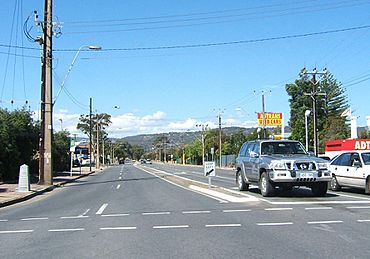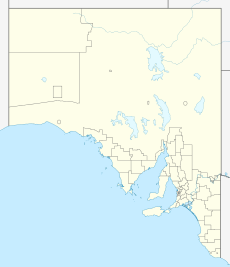St Marys, South Australia facts for kids
Quick facts for kids St MarysAdelaide, South Australia |
|||||||||||||||
|---|---|---|---|---|---|---|---|---|---|---|---|---|---|---|---|

Looking east along Daws Road. St Marys is to the right (south)
|
|||||||||||||||
| Postcode(s) | 5042 | ||||||||||||||
| LGA(s) | City of Mitcham | ||||||||||||||
| State electorate(s) | Elder | ||||||||||||||
| Federal Division(s) | Boothby | ||||||||||||||
|
|||||||||||||||
St Marys is a suburb in Adelaide, South Australia. It is located south of Adelaide's city centre. The suburb is surrounded by Daws Road to the north and South Road to the west. Cashel Street is to the east, and Mill Terrace is to the south. St Marys is part of the City of Mitcham local council area.
One of the biggest parks in the area is St Marys Park. This park was once used as a training ground for the South Adelaide Football Club.
Contents
A Look Back: The History of St Marys
St Marys was first used for farming in the 1830s. The Daw and Ayliffe families were among the first farmers here. Later, other important people like Herschel Babbage, Robert Torrens, and Captain William O’Halloran joined them.
Before the 1850s, the area was called St Marys-on-the-Sturt. At that time, there were only farmhouses and the St Marys Church of England. There were no other buildings between Daws Road and the Sturt River. Later, some shops opened near the church.
St Marys was very important for growing wheat for Adelaide. But when new farming areas opened up in the north, farmers in St Marys started growing other crops. They planted almonds, grape vines, and olives instead.
Early Buildings and Changes
John Daw divided part of his land to create St Marys Village. He built a house at the corner of what is now South Road and Daws Road. In 1852, he sold this house and a large piece of land to Herschel Babbage.
Babbage's own home burned down in 1875. After that, he built a large house that people called "Babbage’s castle." He used a new building material called reinforced concrete. However, he used salty water to mix the concrete, which made the building crumble quickly. His family left the estate in 1896.
A two-story hotel, the Lady MacDonald Hotel, opened in 1857. It was at the corner of South and Ayliffes Road. A sign writer made a mistake, and the hotel's sign read Lady MacDonnell for over 70 years. In 1909, the hotel became a temperance hotel, which meant it stopped selling alcohol. It then went downhill. In the 1930s, it was sold as a home. The old building was pulled down in 1966 and a car dealership was built there.
During the Great Depression, many homeless families found shelter in the crumbling "Babbage’s castle." In 1936, the Babbage estate was divided into smaller blocks of land. This new area was called Castle Estate. These blocks were sold to sailors from the Royal Navy as souvenirs.
Growing the Suburb
In the 1920s, more cars were being used. This led to farms in St Marys being divided into new housing areas. These areas included St Marys Park, Castle Estate, Clovelly Gardens, and South Road Estate.
However, the Great Depression in the 1930s and then World War II slowed down land sales. By 1949, only 25 people lived in these new estates.
The land set aside for Kiley Reserve was used by the Darlington Motorcycle Club for races starting in 1920. Later, in the 1930s, the rest of that area became a trotting track for horse races.
In the 1940s, the South Australian Housing Trust bought the unsold land in St Marys. They built affordable homes for workers. The land that was Kiley Reserve was later bought by the government for the South Road Primary School, which opened in 1951. By 1960, the Housing Trust had built almost 400 homes in St Marys.
When the Chrysler car factory opened in Tonsley Park in 1963, many other businesses that supported the factory started up in St Marys.
Post Offices in St Marys
An unofficial Post Office opened on South Road in 1927. It closed in 1952, and a shop on Quinlan Avenue took over postal services. A new, special Post Office building was built on South Road in 1964. The shop continued postal services until 1975, when they moved to the South Road office. This South Road office was renamed St Marys South in 1967 and closed in 1976. Another office in Clovelly Park opened in 1950, was renamed St Marys in 1967, and closed in 1991.
Changes to Creeks
In 1964, Watiparinga Creek was covered over as part of a drainage project. An old stone bridge from the 1850s, which allowed South Road traffic to cross the creek, was buried when South Road was made wider in 1965. It is still under the road today.
Springfield Creek also ran through St Marys and caused big floods when it rained heavily. In the 1970s, this creek was replaced with drainage pipes and covered over.
Places of Worship and Learning
St Marys Anglican Church
In 1841, John Daw gave one acre of his farm to build the St Marys Church of England. The first church was made of Stringybark wood. By 1847, it was in bad shape, so a new stone church was built nearby. The original wooden church was then used as a school until 1928. The church and its cemetery were officially blessed in 1849. In 1981, the church's name changed to St Marys Anglican Church.
St Marys Baptist Church
The Baptist Union recognized the St Marys Baptist Congregation in 1953. Their first church building was moved from Underdale to St Marys. The current church building was built next to the original one in 1965. This church also ran a community kindergarten from 1953 to 1981.
South Road Primary School
South Road Primary School opened in 1951. It was built on land that was meant to be Kiley Reserve but was never developed. A Junior Primary School opened next to it in 1954.
Over time, fewer children enrolled as the suburb got older. So, in 1980, the Junior Primary School buildings were sold. The children then moved into the main Primary School buildings. The Primary School closed in 1997. The school grounds were sold to the Edwardstown Baptist Church.
St Bernadette’s Primary School
St Bernadette's Catholic Primary School opened in 1952. Nuns from the Dominican group taught there. The school has been targeted by people setting fires, with major arson attacks in 1990, 1997, and 2000.
There are four gum trees along the edge of St Bernadette's oval. These trees are what's left of a double row of gum trees. They were planted along South Road in the 1880s to help bring back trees after too many had been cut down.
Parks and Recreation
St Marys Park
St Marys Park opened in 1929. It was first called the South Road Recreation Ground. The South Adelaide Football Club used it for training and had their clubrooms there. They played their home games at Adelaide Oval.
In 1969, work began to upgrade the oval to SANFL standards. In 1971, the oval was officially reopened as Panther Park. An exhibition game was played between South Adelaide and the 1970 VFL champions, Carlton.
In 1973, South Adelaide built new clubrooms on nearby South Road. The club moved to a new home in Noarlunga in 1995. This was after the Noarlunga Oval was finished. In 1997, Panther Park was renamed St Marys Park.
Interesting Facts About St Marys
- Ayliffes Road was originally the driveway to the Ayliffe family's property in Pasadena.
- Benjamin Street was named by Benjamin Babbage in 1869. The gum trees on this street are the only ones left from the native trees Babbage planted on his land.
- The large gum tree at the corner of The Crescent and Auricchio Avenue is a leftover from the original plants in St Marys.
- Auricchio Avenue was named after Mario Auricchio. He was a local builder who started the Vittorio Veneto Club in the 1930s. This club was a place for people to gather that was not involved in politics.
- The area where St Marys Street and Mingbool Avenue meet is wider than usual. This is because of the drainage pipes for Springfield Creek that run underneath it.
- As of 2022, some homes built in the 1960s are still lived in by their first owners.


